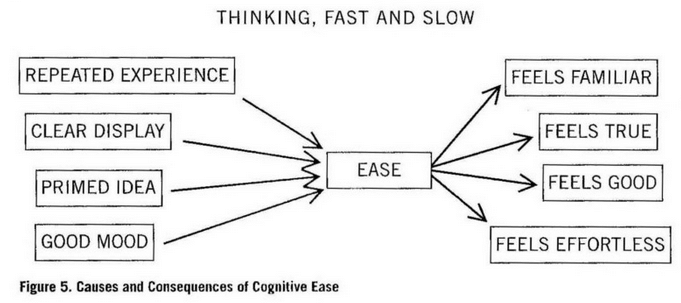Ever tried to write a message you really wanted someone to believe?
Maybe you were faking a note to your PE teacher pretending to be your mom, or pouring your heart into a love letter you hoped would sound deeply sincere. The wild thing? Even if everything you say is 100% true, that doesn’t guarantee people will believe it. The truth is, truth itself is tricky.
What does?
Psychology has some interesting answers.
It turns out, there’s a little mental shortcut people use when deciding whether something “feels” true. It’s called cognitive ease, and the easier your message is to process, the more likely it is to be accepted as true. In fact, you can hack this effect using simple tweaks backed by research.
Let’s explore how to use cognitive ease in your favour—with help from some fascinating studies in psychology and cognitive science.
7 Psychology Truths Behind Illusions
#1 Make it Easy to Read
Take two statements:
• “The hardest bone in the human body is the collarbone.”
• “The hardest bone in the human body is the clavicle.”
They’re both false. But people are more likely to believe the first one. Why? It sounds simpler. It flows. That’s cognitive ease at work.
Bonus tip: If you print your message on high-quality paper, use strong color contrast, or stick to legible colors like red or dark blue, people are more likely to trust what they read. Neon green or pale yellow? Not so much.
#2 Use Everyday Words (Not Academic Jargon)
A great study by psychologist Daniel Oppenheimer looked at how people judge intelligence and credibility based on language. He found that using long, complex words unnecessarily actually makes you seem less intelligent.
His delightfully titled article “Consequences of Erudite Vernacular Utilized Irrespective of Necessity” (a joke in itself) shows that people trust simple, clear language far more than pretentious or overly academic writing.
If you want to be believed, don’t try to sound smart. Try to sound human.
#3 Rhyme for a Reason
Rhyming boosts believability.
Researchers tested this with proverbs. Check this out:
• “Woes unite foes.”
• “Little strokes will tumble great oaks.”
• “A fault confessed is half redressed.”
Now compare them to these non-rhyming versions:
• “Woes unite enemies.”
• “Little strokes will tumble great trees.”
• “A fault admitted is half redressed.”
People rated the rhyming ones as more insightful, even though the content was identical. Rhythm and rhyme make things stick. So if you can, put your message in verse. It helps it land better.
“Mental effort is aversive. The recipients of your message want to stay away from anything that reminds them of effort.”
– Kahneman
#4 Rhyming Isn’t the Only Trick – Try Repetition and Rhythm
Beyond rhyme, repetition and rhythm are powerful memory tools. They make your message feel more familiar—even on the first read.
Why does this matter? Familiar = fluent = believable.
Think about slogans:
• “Just do it.”
• “Have it your way.”
• “Because you’re worth it.”
These work not just because of what they say, but how they say it. Smoothness feels like truth.
#5 Choose Sources with Familiar Names
This one is wild: People trust information more when it comes from a source that’s easy to pronounce.
In a study, participants evaluated fictional financial reports from Turkish companies. One was called Artan, the other Taahhut. Even when the reports conflicted, people gave more weight to the one from Artan, just because the name was easier to say.
We’re hardwired to avoid mental strain. And names that are difficult to pronounce trigger resistance, even subconsciously.
Tip: When quoting or citing, choose familiar or fluent names. It reduces friction and builds trust.
#6 Design Matters (But Don’t Fake It)
All the clever hacks in the world—good fonts, nice paper, catchy rhymes—won’t help if your message flat-out contradicts what your audience already knows. Your message still has to resonate logically or emotionally.
That sense of “truthiness” people get isn’t magic. It’s often just the brain taking mental shortcuts. If something sounds smooth, feels familiar, or comes from a likeable source, it’s more likely to be believed.
That doesn’t mean people are dumb. It just means we’re wired to prefer ease over effort.
A Deeper Psychological Insight from Thinking, Fast and Slow
In the book Thinking, Fast and Slow, psychologist Daniel Kahneman explains how we often believe something not because it’s factually airtight, but because it feels easy, familiar, or rhythmic. Even subtle things—like the fluency of a name or the font used—can sway our judgment of truth.

One visual from the book (Figure 5) shows how multiple factors—logic, association, typography, rhythm—all feed into our feeling of “truth.” It’s tough to separate them, and most of the time, we don’t even try. Our brain just goes with what feels right.
But when we’re really motivated to dig deeper, we can override these mental shortcuts. It just takes effort—something our brains would rather avoid unless we have a good reason.
Final Thoughts
So if you’ve got a message you truly want someone to believe—don’t just focus on the facts. Focus on how it feels to read. Make it smooth, make it simple, maybe even make it rhyme.And if you’re curious about how hidden subconscious cues influence your daily decisions, make sure to check to that article. We dive into the psychology of influence spheres—and you’ll never look at your choices the same way again.
Final Takeaway: Truth Is a Feeling (Sometimes)
Want your message to be believed?
✔️ Make it smooth
✔️ Keep it simple
✔️ Present it beautifully
✔️ Say it like it’s always been said
But most importantly—make it feel easy.
And if you’re curious about how subconscious cues influence your daily decisions, check out my article on The Hidden Subconscious Influences On Our Everyday Life—you’ll be shocked by how often your mind is nudged without your permission.
Cheat Sheet: How to Write Messages People Believe
(Free Download)
I turned all these tips into a one-page printable you can keep or share:




